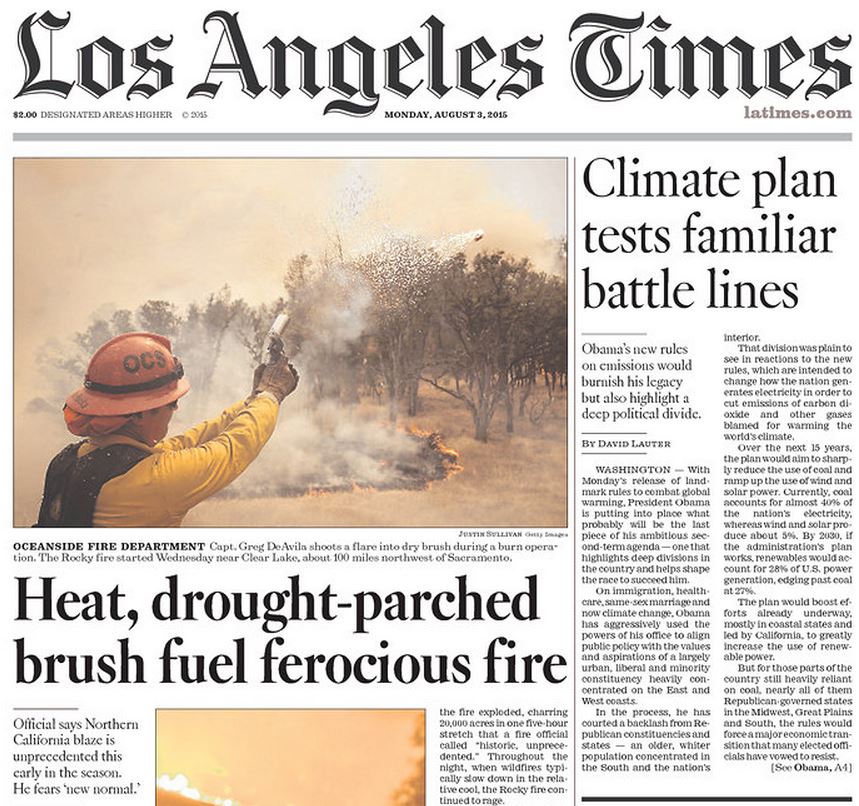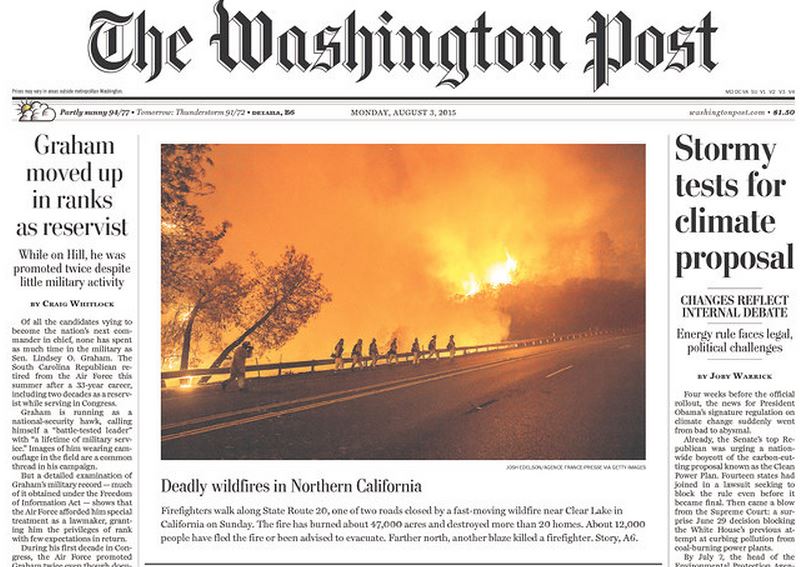Major U.S. newspapers ran front page stories about devastating California wildfires alongside reports on the Environmental Protection Agency's newly-finalized Clean Power Plan, President Obama's flagship policy to address climate change. Yet with only one exception, these newspapers' wildfire articles ignored the documented role that global warming has played in worsening wildfires.
See The Media's Disconnect On Climate Change And Extreme Weather Illustrated On The Front Page
Wildfire Reports Run Alongside Clean Power Plan Stories, But Don't Mention Global Warming
Written by Denise Robbins
Published
Top Newspapers' Front Pages Feature Wildfire Stories That Don't Mention Climate Change
The Los Angeles Times Reported That Unseasonably Early Wildfire Growth Is “The New Normal” -- Without Mentioning Why. The Los Angeles Times mentioned that a spokesman for the California Department of Forestry and Fire Protection called the state's unseasonably early wildfires “the new normal,” but the Times did not mention that climate change is driving the conditions that create this “new normal”:
With the traditional fire season having only recently begun, the intensity of the Rocky fire, along with other major blazes burning throughout the state, has upended long-held expectations and predictions. The unrelenting drought that has parched the state for the last four years has altered the landscape dramatically.

[Los Angeles Times, 8/3/15 via Newseum; Los Angeles Times, 8/3/15]
WSJ And Wash. Post Feature Wire Stories About Wildfires That Ignore Climate Change. The Wall Street Journal featured an image of a California wildfire on the front page, and a story from the Associated Press on page A2 that ignored climate change. The Washington Post similarly published a wildfire image on its front page, along with a Reuters report on page A6 that ignored climate change. Both newspapers also ran front page articles about the Clean Power Plan:


[The Wall Street Journal, 8/3/15 via Newseum; Associated Press, 8/3/15 via The Wall Street Journal; The Washington Post, 8/3/15 via Newseum; Reuters, 8/2/15 via The Washington Post]
USA Today Front Page Highlights 21 Large Wildfires Currently Burning In California, Ignores Climate Change. USA Today reported that one wildfire “has destroyed at least 24 homes and threatens another 6,300,” adding that there are currently “21 large wildfires burning statewide.” The article, which made no mention of climate change, included this infographic showing the vast extent of current wildfires in the West:

Meanwhile, USA Today's article on the Clean Power Plan was relegated to page five, according to Nexis. The article itself noted (emphasis added): “Obama said that climate change is causing hotter summers, rising sea levels, longer wildfires and more destructive extreme weather events.” [USA Today, 8/3/15 via Newseum; USA Today, 8/3/15; USA Today, 8/3/15]
By Contrast, The New York Times Thoroughly Discussed Climate Change Connection To Wildfires
NY Times Featured Climate Change Connection Prominently In Wildfire Story. The New York Times' August 2 front page article featured an image of California's wildfires on the top fold, as part of a report on how drought and heat are leading to worsening wildfires in the West and other places across the globe. The Times interviewed Peter J. Goldmark, Washington's commissioner of public lands, who noted: “Our fire season started a month ahead, our crops matured weeks ahead and the dry weather we usually get in August, we've had since May ... By heavens, if this isn't a sign of climate change, then what is climate change going to bring?” The Times continued:
The entire region is under duress. It has been so dry for so long that federal officials have warned about the potential for more catastrophe in the months ahead, as drought and climate change push high temperatures higher, drying already-arid lands.
[...]
According to findings by NASA and the National Oceanic and Atmospheric Administration, 10 of the warmest years on record have occurred since 1998. Already, 2015 is challenging 2014 for the No. 1 spot on that list.
“It's like a bank account you can't balance,” said A. Park Williams, a bioclimatologist at the Lamont-Doherty Earth Observatory of Columbia University in Palisades, N.Y., who has studied the effects of climate change in living organisms. “You deposit moisture, but so much of it is withdrawn through heat and evaporation there just isn't enough to meet the demand.”
Scientists have spoken of “climatological extremes” as the new normal, a trend underlined by this year's El Niño pattern, which brought extraordinary rainfall to the Southwest, causing deadly floods in Texas while wiping out short-term drought conditions in eastern New Mexico. [The New York Times, 8/2/15]
Below this front page story was its report on the Clean Power Plan, which the Times noted will “sharply cut planet-warming greenhouse gas emissions from the nation's power plants and ultimately transform America's electricity industry.” The article also included President Obama's quote: “Climate change is not a problem for another generation, not anymore.” [The New York Times, 8/2/15 via front pages, 8/2/15]
Media Typically Overlook Connection Between Wildfires And Climate Change
Reports: Media Rarely Connect California Wildfires To Climate Change. Previous Media Matters analyses have found that local and national media coverage largely overlooked the role of global warming in California's wildfires. For example, California newspapers mentioned climate change in only 11 percent of their stories during a three month period in 2014, and only seven percent of their stories during a similar timeframe in 2013. And in 2013, major nationally-circulated newspapers mentioned climate change in just nine percent of their wildfire coverage, while national television outlets mentioned climate change in just four percent of their wildfire coverage.

[Media Matters, 6/18/14; 7/3/13]
Experts Agree Climate Change Is Causing Wildfire Seasons To Become Longer, More Extreme
National Climate Assessment: Climate Change Increasing Wildfire Risk In Southwest. The 2014 National Climate Assessment (NCA) -- a federal report compiled from hundreds of scientific papers on the impacts of climate change -- included "[i]ncreased wildfire" as one of the “key messages” for the Southwest region. The report stated: “Increased warming, drought, and insect outbreaks, all caused by or linked to climate change, have increased wildfires and impacts to people and ecosystems in the Southwest. Fire models project more wildfire and increased risks to communities across extensive areas.” The Assessment also stated that wildfires in the Southwest are expected to increase as climate change continues, “including a doubling of burned area in the southern Rockies, and up to 74% more fires in California.” [U.S. Global Change Research Program, 5/6/14; accessed 8/3/15]
Nature Communications Study Author: Increased Wildfires From Climate Change May Be The “New Normal.” A recent study published in Nature Communications found that fire seasons are nearly 20 percent longer than they were 35 years ago. The lead author told InsideClimateNews: “Conditions across the U.S. are becoming more conducive to fires ... We may be moving into a new normal. If these trends persist, we are on track to see more fire activity and more burned area.” The InsideClimateNews article added:
“This study adds to a growing body of knowledge about the increases in wildfire risk and climate change,” said Chris Field, director of the Department of Global Ecology at the Carnegie Institution for Science. “There are multiple factors that can cause wildfires. What the study shows is that weather opens the door to fire risk,” he explained: The number of fires may not necessarily increase, but the risk goes up.
The result comes at a time when the United States is battling a severe fire season. Though the number of fires has been fewer than the 10-year average of wildfires, until this date, the extent of acreage that has been affected by the fires is significantly greater. It crossed the 5-million-acre mark by about mid-July, which is vastly more that the average of 2.9 million acres from 2005 to 2014). [Nature Communications, accessed 8/3/15; ClimateWire, 7/15/15]
Union of Concerned Scientists Detailed How Western Wildfires Are Getting Worse. The Union of Concerned Scientists (UCS) laid out how climate change has worsened wildfires in the western United States in an infographic, which shows how increased temperatures are causing the region's snowpack to melt sooner and subsequently drying out forests, “prim[ing]” conditions “for wildfires to ignite and spread.” UCS detailed how as temperatures continue to increase, the amount of land burned by wildfires is also expected to increase:

[Union of Concerned Scientists, accessed 8/3/15]